Choosing the right downlight seems simple until you face all the options. A wrong choice can leave your space poorly lit. Understanding the key differences ensures perfect lighting every time.
An IP44 fixed downlight provides a static, single-direction beam of light, ideal for general illumination. An IP44 adjustable downlight features a tilting mechanism, allowing you to direct the light beam towards specific areas or objects. The choice depends on whether you need ambient or focused light.
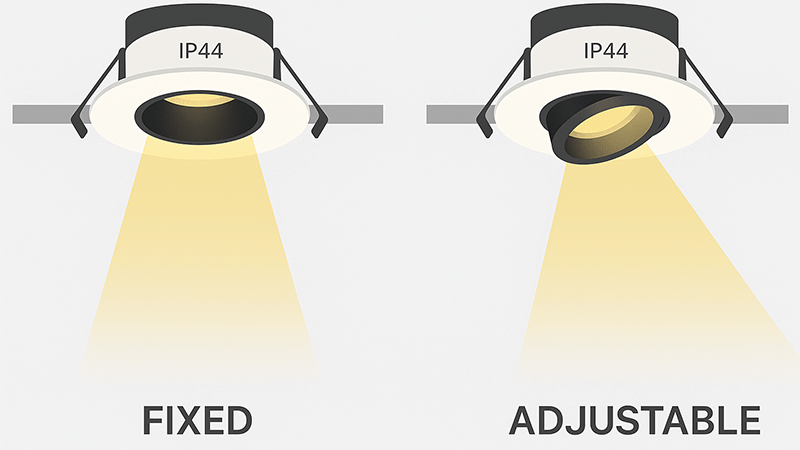
I’ve spent my entire career in the lighting industry, from working on the factory floor to founding my own company, iPHD. I've helped countless partners like Shaz, a purchasing manager in the UAE, navigate these very questions. We've found that the best lighting solution always starts with a clear understanding of the basics. So, let’s break down everything you need to know about fixed versus adjustable downlights1 to make sure you get it right for your project. Keep reading, and I'll walk you through it step by step.
What Does Fixed Lighting Actually Mean?
Your project needs reliable, consistent light, but you're worried about creating uneven shadows. Choosing the wrong fixture can result in dark spots. Fixed lighting provides the uniform illumination you need.
Fixed lighting refers to a luminaire that casts light in a single, unchangeable direction, typically straight down. Its purpose is to provide broad, even illumination across a general area, also known as ambient lighting2. It’s a simple, set-and-forget solution for overall brightness.
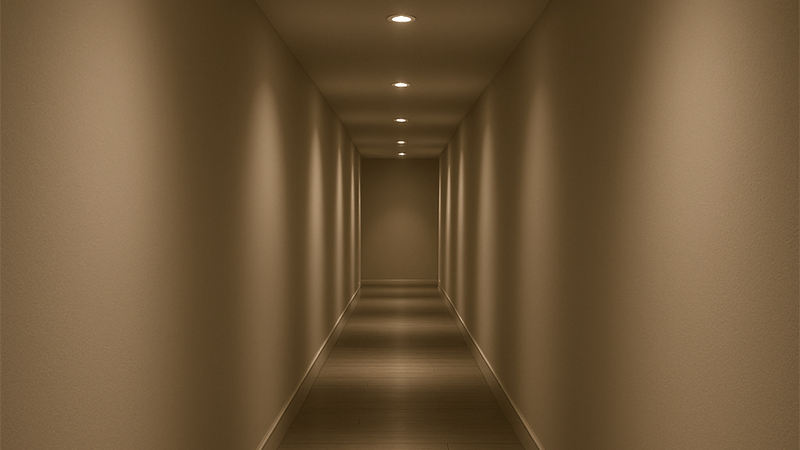
In my experience, fixed downlights are the workhorses of the lighting world. They are designed to do one job and do it exceptionally well: provide consistent, general light. Think of them as the foundation of your lighting plan. The beam is directed straight down from the fixture, and it cannot be angled or redirected. This makes them perfect for applications where you need uniform brightness across a wide space and don't want the light to be accidentally knocked or aimed incorrectly.
I remember working with Shaz on a large residential complex in the UAE. The project required lighting for long, outdoor covered corridors connecting the buildings. He needed a solution that was efficient, low-maintenance, and tamper-proof. Fixed IP44 downlights were the clear winner. We installed them at regular intervals to create a seamless path of light. Because they were fixed, residents couldn't alter the direction, ensuring the walkways remained safely and evenly lit every single night. This is where their simplicity becomes a major strength.
Key Characteristics of Fixed Downlights
| Feature | Description | Best Use Case |
|---|---|---|
| Beam Direction | Static, pointing straight down. | General ambient lighting. |
| Simplicity | No moving parts, easy to install. | Hallways, large open-plan offices, basic room illumination. |
| Cost | Typically more budget-friendly than adjustable models. | Projects with tight budgets needing wide coverage. |
| Aesthetics | Offers a clean, flush, and uniform ceiling appearance. | Minimalist designs where fixtures should not stand out. |
You choose fixed lighting3 when the primary goal is simply to light up a room. It's less about creating drama or highlighting features and more about fundamental visibility and comfort. For spaces like utility rooms, garages, or large commercial areas, the reliability and even coverage of fixed downlights are exactly what you need.
And What Exactly is an Adjustable Light?
You have a beautiful piece of art or an interesting architectural feature, but it's lost in the shadows. Standard lighting feels flat and uninspired. Adjustable lights let you direct attention right where you want it.
An adjustable light, often called a tilt or gimbal downlight4, has a mechanism that lets you pivot or angle the lamp. This allows you to direct the beam of light precisely onto a specific object, wall, or task area, creating accent or focused light5ing.
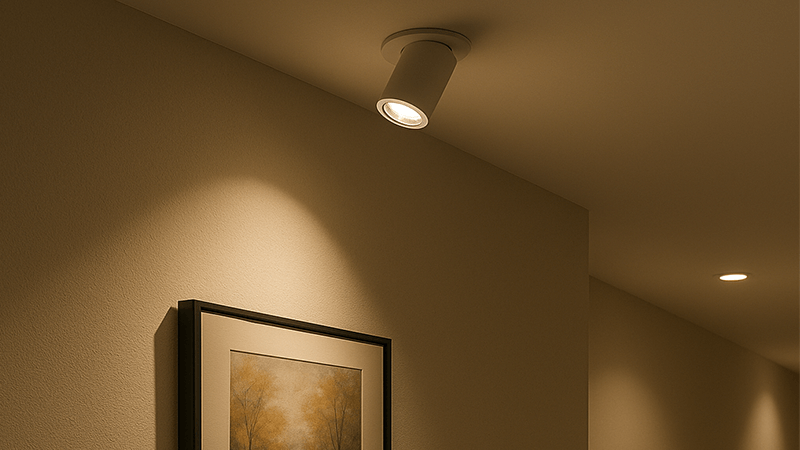
Adjustable downlights introduce flexibility and control into your lighting design6. While a fixed downlight creates a pool of light directly below it, an adjustable one lets you "point" that light. This function is usually achieved with a gimbal mechanism that allows the light source to tilt, typically up to 30 degrees, and sometimes even rotate 360 degrees. This seemingly small feature completely changes the fixture's purpose from general illumination to a precision tool. It allows you to "paint with light," creating layers, depth, and focal points within a room.
I worked on a restaurant project where the owner wanted to create an intimate mood while also making sure key areas were functional. We used adjustable IP44 downlights strategically. Above the beverage prep station, we angled them directly onto the workspace. This provided the staff with clear, bright task lighting7 for safety and efficiency, without flooding the entire bar area with harsh light. Over in the dining area, we aimed other adjustable downlights at the textured feature walls and menu boards. This created beautiful visual interest and drew the customers' eyes exactly where the owner wanted them to go. This level of control is something you can only achieve with adjustable fixtures.
Key Characteristics of Adjustable Downlights
| Feature | Description | Best Use Case |
|---|---|---|
| Beam Direction | Flexible, can be tilted and sometimes rotated. | Accent lighting, task lighting, wall washing8. |
| Versatility | Adapts to changing room layouts or focal points. | Art galleries, retail displays, kitchens, multi-use rooms. |
| Control | Allows for precise highlighting of specific features. | Highlighting artwork, architectural details, or workspaces. |
| Aesthetics | Can create dramatic, layered lighting effects. | Spaces designed to have mood and character. |
These are your go-to fixtures for adding character to a space. Whether you're in a garden room and want to highlight a beautiful plant, or in a living room aiming light at a fireplace, the ability to direct the beam is what makes adjustable downlights so valuable.
Is an IP65 Rating Always Better Than IP44?
You see different IP ratings and assume higher is always better, leading to overspending. But installing a light with the wrong rating can be inefficient or even unsafe. Understanding the difference is key.
No, IP65 is not always better. IP65 offers total protection from dust and low-pressure water jets, while IP44 protects from objects larger than 1mm and water splashes. "Better" depends on the location; IP44 is sufficient for most indoor damp areas, whereas IP65 is for direct water exposure.
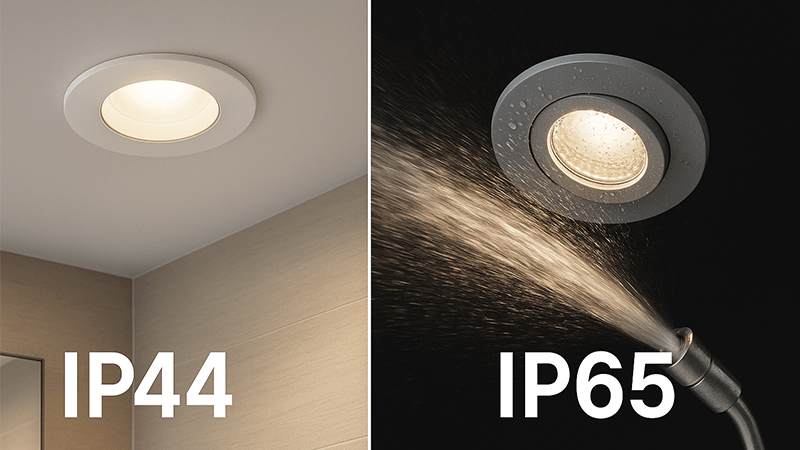
As a manufacturer, I deal with specs and ratings every day, and one of the most common points of confusion is the IP (Ingress Protection) rating. It’s easy to think a bigger number means a better product, but it’s really about matching the product to the environment. The IP rating is a two-digit code that tells you how well a fixture is sealed against solids (like dust) and liquids (like water). It’s not a measure of overall quality, but of specific resistance.
I once had a client planning a large office renovation. They were about to order IP65-rated downlights for the entire building, including all the office spaces and hallways. They believed it was the "safest" option. I walked them through what the numbers actually mean. For most of the office, IP20 would have been fine. For the pantry ceiling near the water dispenser and in the bathrooms away from the showers, IP44 was more than enough to protect against any potential splashes. IP65, which protects against water jets, was complete overkill and would have significantly increased their costs. We revised the order, using IP44 fixtures in the designated damp areas and saving the client a substantial amount of money. It’s about being smart, not just safe.
Understanding the Numbers: IP44 vs. IP65
The first digit relates to protection against solid particles, and the second relates to protection against liquids.
| IP Rating | First Digit (Solids) | Second Digit (Liquids) | Common Application |
|---|---|---|---|
| IP44 | 4: Protected against solid objects >1mm (e.g., wires, screws). | 4: Protected against water splashes from any direction. | Bathroom ceilings (away from shower), covered patios, office pantries. |
| IP65 | 6: Totally dust-tight. No ingress of dust. | 5: Protected against low-pressure water jets from any direction. | Areas that may be hosed down, walk-in showers, exposed exteriors. |
So, is IP65 better? Only if you plan on jet-washing your ceiling. For most indoor and covered outdoor downlight applications, IP44 provides the exact level of protection needed against steam, moisture, and accidental splashes. Choosing the right rating is a matter of efficiency and smart project management.
So, When Should You Use Adjustable Downlights?
Your space feels one-dimensional, and important details go unnoticed in flat, even light. You’re frustrated that the room lacks character or focus. Use adjustable downlights to strategically add drama and function.
Use adjustable downlights whenever you need to direct light to a specific location. This includes accent lighting for art or architecture, task lighting for work surfaces like kitchen counters, and wall washing to make a room feel larger or highlight a texture.
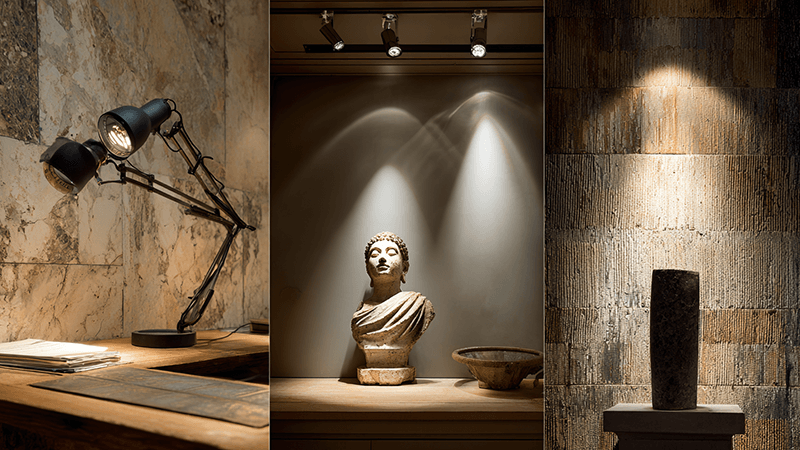
The decision to use an adjustable downlight comes down to one question: do I need to control where the light goes? If the answer is yes, then an adjustable fixture is your tool. Their flexibility allows for a much more dynamic and intentional lighting scheme compared to the broad strokes of fixed lighting. This control can serve several distinct purposes within a single project, transforming a space from simply being lit to being well-designed. I've seen them used to solve countless design challenges over the years.
For example, Shaz, my partner in the UAE, often sources lighting for high-end residential projects. In these homes, owners have valuable art collections and unique architectural features. We exclusively use adjustable downlights in these areas. It allows the homeowner to perfectly illuminate a new painting or sculpture, and if they decide to rearrange the room, the lighting can be easily re-angled to suit the new layout without an electrician. This adaptability is a luxury feature that adds significant value. It gives the end-user control over their own environment, which is the hallmark of great design.
For Accent Lighting
This is the most common use. You can create focal points that draw the eye, turning a simple wall into a gallery. Think of a beam of light precisely hitting a sculpture, a family portrait, or a beautiful floral arrangement. This creates contrast and a sense of importance.
For Task Lighting
In kitchens, offices, and workshops, general overhead lighting can cause you to cast a shadow on your work surface. By angling an adjustable downlight directly onto your counter, desk, or workbench, you get bright, focused light right where you need it for tasks like chopping vegetables or reading documents.
For Wall Washing and Grazing
You can aim adjustable downlights at a wall to create different effects. "Wall washing" involves positioning the light to cast a wide, even layer of light, which can make a small room feel more spacious. "Grazing" involves placing the light very close to a textured surface like brick or stone to create dramatic shadows that highlight the texture.
Ultimately, adjustable downlights are for when you want to be the director of the light in your space.
Conclusion
Choose fixed downlights for uniform, general lighting and adjustable ones for focused accent or task light. Always match the IP rating, like IP44, to protect against environmental conditions like moisture.
Find out how adjustable downlights can add character and functionality to your lighting design. ↩
Discover the importance of ambient lighting in creating a comfortable and inviting atmosphere in any space. ↩
Understand the concept of fixed lighting and its role in providing consistent illumination across various settings. ↩
Explore the features of gimbal downlights and how they offer versatility in directing light. ↩
Find out how focused light can transform your space by highlighting specific areas or features. ↩
Learn about the principles of lighting design and how to create effective lighting schemes. ↩
Learn about task lighting and its significance in enhancing visibility for specific activities. ↩
Discover the technique of wall washing and how it can enhance the perception of space. ↩

